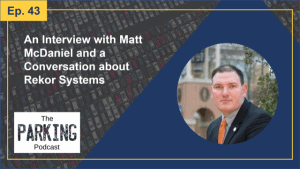By Bill Smith and Craig Smith
WHEN IPMI VISITS SAN ANTONIO, TEXAS, NEXT JUNE, Conference & Expo attendees will  have a chance to see an innovative parking project. H-E-B, the Texas-based grocery retailer, is close to completing the development of a new five-level parking garage that will provide 744 spaces to employees and visitors to the company’s historic Arsenal Campus. This parking project apart is set apart because the new garage is located across the busy, four-lane Cesar Chavez Boulevard from the campus and features a skybridge pedestrians can use to safely move to and from the parking garage.
have a chance to see an innovative parking project. H-E-B, the Texas-based grocery retailer, is close to completing the development of a new five-level parking garage that will provide 744 spaces to employees and visitors to the company’s historic Arsenal Campus. This parking project apart is set apart because the new garage is located across the busy, four-lane Cesar Chavez Boulevard from the campus and features a skybridge pedestrians can use to safely move to and from the parking garage.
The project is part of a larger expansion of H-E-B’s headquarters campus, which has created the need for more parking. The parking garage and bridge project is part of a $100 million master plan, under which the company plans to add 1,600 employees to its downtown headquarters by 2030.
As might be expected, it was challenging to find the necessary space to develop parking in this bustling area, but the development team came up with a solution that permitted H-E-B to build the new parking facility within the corporate campus. The addition of the skybridge ensured that the new development provides safe and convenient parking for employees and visitors without affecting traffic on the busy street.
“Success often leads to a need for more parking,” says Casey Wagner, executive vice president and managing director of the Houston office of Walker Consultants, the parking consultant on the project. “Meeting that additional need often requires creativity, and this project stands out in that regard. The entire team, starting with the owner, showed a truly creative spirit.”
Meeting Increased Parking Need
In a sense, developing necessary parking was the simple part of the project. There was an existing parking lot on which the new structure could be built, which served as the project footprint.
The garage was designed to architecturally complement H-E-B’s historic headquarters building, which has played an important role in San Antonio’s history. The building was originally established as an arsenal and is still known as The Arsenal. It was established as the predecessor to Fort Sam Houston and supplied ammunition and provisions to troops in four armed conflicts, beginning with the Civil War.
Given the historic importance of H-E-B’s headquarters building, it was imperative that the new garage complement it architecturally while fitting seamlessly into the neighborhood. To achieve this, the garage was constructed with a mix of materials that included steel, concrete, metal screening, metal fencing, D’Hanis brick, and other masonry elements. The completed garage beautifully achieves its architectural goals while providing a safe and convenient parking experience.
The five-level deck boasts a number of amenities designed to improve the parking experience, including rows of rooftop-shading trellis aligned above the parking spaces to provide shade and reduce the garage’s carbon footprint. LED lighting is used throughout the garage to enhance visibility and improve safety while reducing operational costs through enhanced efficiency. Extensive landscaping improves the project’s aesthetics while further reducing the garage’s carbon footprint. Finally, wire fencing is used to establish the borders of the parking complex.
“Improving the parking experience is a vitally important consideration when you design a parking facility on a corporate campus,” Wagner says. “If employees can park their vehicles quickly and conveniently, they can get to their workstations or to meetings more efficiently and in a better frame of mind. The work day is much more pleasant for employees when it gets off to a good start in the parking facility, and those employees are typically more productive and effective at work. The Arsenal Building garage accomplishes all of these goals.”
Reaching for the Sky
What really stands out about the new garage is a pedestrian skybridge that allows pedestrians to safely walk to the Arsenal Building. One of the most challenging aspects of the project was to create a way for drivers to traverse the busy four-lane Cesar Chavez Boulevard after they park their vehicles. Of course, safety wasn’t the only consideration. Traffic management can be a nightmare for such a busy street, particularly when it needs to accommodate large numbers of people crossing the boulevard on foot during peak commuting times.
The skybridge was an obvious solution but one that had the potential to fall into the “easier-said-than-done” category. The historic nature of the Arsenal Building was a potential roadblock. In a city like San Antonio that’s acutely aware of its history—and justifiably proud of it—it can be difficult to gain the necessary support for development that will fundamentally alter the architectural personality of the area. That’s one of the reasons the San Antonio Conservation Society has traditionally balked at the idea of skybridges.
Potential opposition was avoided through the creation of a design that ensured the skybridge would complement local design while standing out as an architectural marvel on its own. San Antonio is a city of bridges. If you’ve had the privilege of visiting the city’s Riverwalk or taking a boat trip along the San Antonio River, you’ve experienced them. The South Alamo, Lojoya, Presa, Navarro, St. Mary’s, Market, Commerce, and Crockett bridges allow residents and tourists to cross the San Antonio River to visit its world-famous shops and restaurants.
This skybridge was designed to evoke the historic bridges along the San Antonio River and complement the city’s beautiful landscape. Designed by project architect Ford, Powell & Carson, it is constructed of cast concrete with chipped edges and stacked clay tile.
Casting the necessary concrete and installing the skybridge onsite would have required closing Che Guevara Boulevard for several days, which wasn’t really an option. As such, the skybridge was built offsite with precast concrete and delivered to the site in three sections, which were then assembled and lifted into place in a single night, while traffic was negligible. The finished skybridge is 160 feet long and 10 feet tall by 10 feet across. It stands 27 feet above the busy four-lane roadway.
“The pedestrian bridge connecting the garage to the Arsenal Building was the ideal solution,” Wagner says. “It’s an essential element of the parking program because it provides safe and convenient access to and from the garage, while minimizing the impact of the parking garage on traffic in the area.
PROJECT DETAILS
Location: San Antonio, Texas
Owner: H-E-B
Development team: Walker Consultants, parking consultant and structural engineer
Ford, Powell & Carson, architectural firm
Whiting-Turner, general contractor
Number of parking spaces: 744
Levels: Five elevated decks and two bays
Estimated construction budget: $19 million
The work day is much more pleasant for employees when it gets off to a good start in the parking facility, and those employees are typically more productive and effective at work. The Arsenal Building garage accomplishes all of these goals.
“It’s also a stunning addition to the local architecture,” Wagner continues. “The way it reflects San Antonio’s character is tremendous.”
The completed garage beautifully achieves its architectural goals while providing a safe and convenient parking experience.
Read the article here.
BILL SMITH is principal of Smith-Phillips Communications and contributing editor to Parking & Mobility. He can be reached at bsmith@smith-phillips.com.
CRAIG SMITH is a freelance writer. He can be reached at smithcw48@gmail.com.

 An Interview with Matt McDaniel and a Conversation about Rekor Systems
An Interview with Matt McDaniel and a Conversation about Rekor Systems

